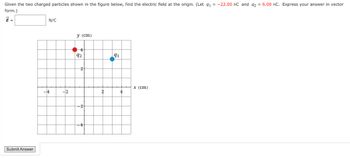Question

Transcribed Image Text:Given the two charged particles shown in the figure below, find the electric field at the origin. (Let q₁ = -22.00 nC and 92 = 6.00 nC. Express your answer in vector
form.)
E =
Submit Answer
N/C
-4
-2
y (cm)
4
92
91
x (cm)
Expert Solution
This question has been solved!
Explore an expertly crafted, step-by-step solution for a thorough understanding of key concepts.
Step by stepSolved in 5 steps with 3 images

Knowledge Booster
Similar questions
- The drawing shows a positive point charge g₁, a second point charge g₂ that may be positive or negative, and a spot labeled P, all on the same straight line. The distance d between the two charges is the same as the distance between ₁ and the spot P. With g₂ present, the magnitude of the net electric field at P is twice what it is when q₁ is present alone. Given that q₁ = 0.50 μ C, determine 92. 92 d +91 d Parrow_forwardGiven the two charged particles shown in the figure below, find the electric field at the origin. (Let 91 1049001 + 129100j N/C ↑E = 4 92 2 y (cm) 4 № -2 HP 4 2 91 x (cm) = : -26.00 nC and 92 = 4.00 nC. Express your answer in vector form.)arrow_forwardThe figure below shows a small, charged bead, with a charge of q = +41.0 nC, that moves a distance of d = 0.174 m from point A to point B in the presence of a uniform electric field E of magnitude 255 N/C, pointing right. A positive point charge q is initially at point A, then moves a distance d to the right to point B. Electric field vector E points to the right. (a) What is the magnitude (in N) and direction of the electric force on the bead? magnitude Ndirection (b) What is the work (in J) done on the bead by the electric force as it moves from A to B? J (c) What is the change of the electric potential energy (in J) as the bead moves from A to B? (The system consists of the bead and all its surroundings.) PEB − PEA = J (d) What is the potential difference (in V) between A and B? VB − VA = Varrow_forward
- Can you please help me with this question? I appreciate your help!arrow_forwardGiven a charge q1=50nC located at the XY coordinates (5m, 10m) and a charge q2= -20nC located at the XY coordinates (-3m, -1m). Find the field point has coordinates (-3m. 4m). Find the unit vector r1_ hat and r2_hat?arrow_forwardÈ= [dE = [k9 .. Start with... f... dxarrow_forward
- Given the two charged particles shown in the figure below, find the electric field at the origin. (Let q₁ = -24.00 nC and 92 = 8.00 nC. Express your answer in vector form.) E E = N/C -4 -2 y (cm) 92 2 91 4 x (cm)arrow_forwardThe figure below shows a small, charged bead, with a charge of q = +42.0 nC, that moves a distance of d = 0.189 m from point A to point B in the presence of a uniform electric field E of magnitude 270 N/C, pointing right. A positive point charge q is initially at point A, then moves a distance d to the right to point B. Electric field vector E points to the right. (a) What is the magnitude (in N) and direction of the electric force on the bead? magnitude Ndirection (b) What is the work (in J) done on the bead by the electric force as it moves from A to B? J (c) What is the change of the electric potential energy (in J) as the bead moves from A to B? (The system consists of the bead and all its surroundings.) PEB − PEA = J (d) What is the potential difference (in V) between A and B? VB − VA = Varrow_forwardGiven the arrangement of charged particles in the figure below, find the net electrostatic force on the q1 = 5.15-µC charged particle. (Assume q2 = 12.33 µC and q3 = −21.12 µC. Express your answer in vector form.)arrow_forward
arrow_back_ios
arrow_forward_ios